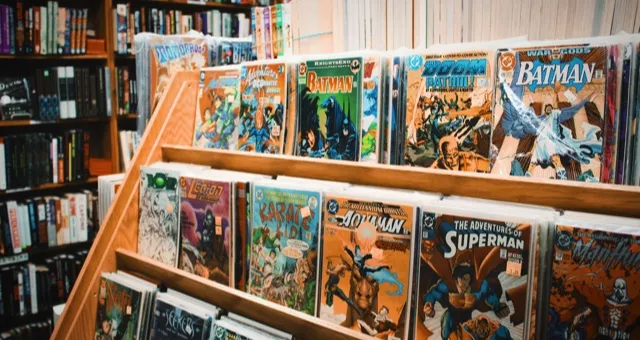So you’ve picked up a copy of
Smile or
Fun Home or
Black Panther: A Nation Under Our Feet and you are totally digging it. Words! Pictures! Words and pictures! You got your chocolate in my peanut butter! etc. etc.
But what exactly is this thing you’re reading? Is it a
comic? Is it a comic book? Is it a graphic novel? And will people make fun of you if you call it the wrong thing?
No worries, dear reader: you’re among friends. Let’s talk.

Comics
The general term for the thing with the words and the pictures and the speech bubbles is
comics. That’s it! It’s super duper simple. It is a
comic. You are reading
comics. This applies whether you are picking up the latest issue of
Batman, or chuckling over Garfield’s latest Monday tribulations, or perusing a serious work like
Persepolis.
Comics is a catch-all term for the medium and the form and the category. They are all
comics.
(Another way of describing this method of storytelling is
sequential art, i.e. art in a sequence. This term was coined by the legendary Will Eisner in 1985. All comics are told via sequential art, but it’s a way bigger mouthful. Just say comics.)
Okay, so what’s the difference between
comics and a
comic book? Colloquially speaking, the term
comic book is usually applied to periodicals. So an issue of
Wonder Woman or
Spider-Man or
Jughead is a
comic book, but a longer work like the aforementioned
Smile or
Fun Home wouldn’t typically be called a
comic book, just a
comic.
In other words, if the comic is a book, it’s not a comic book. I’m so sorry.
Honestly, though, if you mix them up, it is 100% not a big deal. It’s casual terminology. There is no comics police. (Death to the Comics Code Authority!)
What about the stuff in the newspaper?
Garfield, Peanuts, Calvin & Hobbes? Those are called
comic strips, which makes sense when you look at the shape of them.
Comic strips also fall under
comics. If they’re collected in a book form they are still
comics, or a
comic strip collection, or hell, even a
comic book, please don’t stress out about it.
If it originated online it’s a
webcomic.
Webcomics are still
comics.
But wait, what about graphic novels?
So you’ve heard someone say that the proper, grown-up,
serious term for them is
graphic novels. And sure, graphic novel works! (The term, by-the-by, was coined by comics historian Richard Kyle in 1964 and popularized in the mainstream in the ’80s by books like Art Spiegelman’s
Maus and the works of creators like Frank Miller and Alan Moore. The more you know!) It’s a totally valid term. It’s what Barnes & Noble uses to label their shelves. It’s
fine.
The problem is, so few of the books typically referred to as graphic novels are actually, you know…
novels.
Maus is the
graphic nonfiction account of Spiegelman interviewing his father about surviving the Holocaust.
Persepolis is a
graphic autobiography.
Fun Home is a
graphic memoir. Even
The Dark Knight Returns and
Watchmen are collections of previously published periodicals; they’re fiction, but they’re only loosely speaking novels.
So yes, you
can use
graphic novel to describe any of these things and people will know what you mean, but it’s a pet peeve for many fans (especially here at Book Riot) because the word “novel” doesn’t actually apply to so many of these books. Moreover, reaching for
graphic novel can carry an air of snobbery, like you’re searching for a more highfalutin phrase than
comics when really…they’re all comics.
And there’s nothing wrong with that.
By all means, use graphic novel when you’re talking about a novel told in graphic format! And use graphic memoir or graphic nonfiction or graphic…I don’t know, cookbook or whatever, in the cases where that applies. But don’t shy away from
comics because you think the word is inaccurate or lowbrow.
They’re all comics. And comics are great.
A Few More Things
Monthly periodical comic books (e.g.
X-Men #153) are also sometimes referred to as
single issues or
floppies.
A
trade paperback has, frustratingly, several definitions in publishing, but in the comics word it’s generally used to mean a collection of single issues, e.g.
Ms. Marvel #1–6 was collected into a
trade paperback called
Ms. Marvel Volume 1: No Normal.
Original graphic novel or
OGN is a term that has declined slightly in use but is used to distinguish a book published initially as a graphic novel from one that is a collection of previously published single issues.
Catwoman Volume 1: Copycats is a
trade paperback but
Under the Moon: A Catwoman Tale is an
original graphic novel.
Manga simply means comics created in Japan or in Japanese and encompasses a massive range of genres and visual styles. I am far from an expert, but I mention it here because it’s another term that’s often thought to refer to a small, pigeonholed thing instead of a vast art form.
Manhwa is the corresponding term for Korean comics.
I hope this helped! Still not sure what words to use when? Tag in Book Riot to ask us on social!










